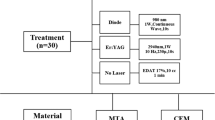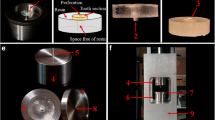Abstract
Proper bond strength of endodontic materials is an essential factor in the final success of root canal treatments, including perforation repairs. This study was designed to evaluate the effect of two power outputs of Nd:YAG laser (1064 nm) on push-out bond strength (PBS) of ProRoot mineral trioxide aggregate (MTA) and calcium-enriched mixture cement (CEM Cement) in the repair of artificial furcal perforations. This ex vivo study enrolled 66 extracted human molars. After preparing the access cavity, perforations were created on the floor of the pulp chamber with a diameter of 1.4 mm. The teeth were randomly distributed into the following six groups according to the repair material (MTA and CEM) and power output of laser irradiation (1 W and 1.5 W); A: MTA (case), B: CEM (case), C: Nd:YAG (1 W)/MTA, D: Nd:YAG (1 W)/CEM, E: Nd:YAG (1.5 W)/MTA, and F: Nd:YAG (1.5 W)/CEM. Then, a universal testing machine was utilized to assess the PBS. Data analysis was performed using ANOVA and T tests. Significant level was considered at P < 0.05. The highest mean ± SD of PBS was noted in Group Nd:YAG (1 W)/MTA (58.92 ± 36.13), followed by Nd:YAG (1.5 W)/MTA > Nd:YAG (1.5 W)/CEM > Nd:YAG (1 W)/CEM > MTA > and CEM. A significant difference was noted between laser and non-laser applications (P < 0.05). However, the increase of power output from 1 to 1.5 W had no significant influence on PBS (P > 0.05). The PBS of MTA groups was always significantly greater than that of CEM groups (P < 0.05). Although Nd:YAG laser irradiation positively influenced on PBS values in both material studied, increasing power output was not effective.

Similar content being viewed by others
References
Ghasemi N, Reyhani MF, Milani AS, Mokhtari H, Khoshmanzar F (2016) Effect of calcium hydroxide on the push-out bond strength of endodontic biomaterials in simulated furcation perforations. Iran Endodontic J 11(2):91
Reyhani M-F, Ghasemi N, Zand V, Mosavizadeh S (2017) Effects of different powder to liquid ratios on the push out bond strength of CEM cement on simulated perforations in the furcal area. J Clin Exp Dent 9(6):e785
Ghasemi N, Rahimi S, Lotfi M, Solaimanirad J, Shahi S, Shafaie H et al (2014) Effect of mineral trioxide aggregate, calcium-enriched mixture cement and mineral trioxide aggregate with disodium hydrogen phosphate on BMP-2 production. Iran Endodontic J 9(3):220
Yazdi KA, Bolhari B, Sabetmoghaddam T, Meraji N, Kharazifard MJ (2017) Effect of blood exposure on push-out bond strength of four calcium silicate based cements. Iran Endodontic J 12(2):196
Nematollahi Z, Khosraviani F, Esnaashari E, Kariminia K, Delvarani A (2021) Comparative evaluation of push-out bond strength and bond failure mode of ortho MTA and ProRoot MTA. EAS J Dent Oral Med 3(5):121–126
Haghgoo R, Niyakan M, Moghaddam KN, Asgary S, Mostafaloo N (2014) An in vitro comparison of furcal perforation repaired with pro-root MTA and new endodontic cement in primary molar teeth-a microleakage study. J Dent 15(1):28
Francis T, Joshi SB, Pai AV, Sakkir N, Thaha KA (2019) Comparison of the sealing ability of MTA-angelus, Biodentine and CEM cement in the repair of large furcal perforations-a bacterial leakage study. J Clin Diagn Res 13(1):32–35
Ramazani N, Sadeghi P (2016) Bacterial leakage of mineral trioxide aggregate, calcium-enriched mixture and Biodentine as furcation perforation repair materials in primary molars. Iran Endodontic J 11(3):214
Sahebi S, Moazami F, Shojaee NS, Layeghneghad M (2013) Comparison of MTA and CEM cement microleakage in repairing furcal perforation, an in vitro study. J Dent 14(1):31
Sahebi S, Sobhnamayan F, Naghizade S (2016) The effects of various endodontic irrigants on the push-out bond strength of calcium-enriched mixture cement and mineral trioxide aggregate. Iran Endodontic J 11(4):280
Lotfi M, Ghasemi N, Rahimi S, Bahari M, Vosoughhosseini S, Saghiri MA et al (2014) Effect of smear layer on the push-out bond strength of two endodontic biomaterials to radicular dentin. Iranian endodontic journal 9(1):41
Ghasemi N, Reyhani MF, Salem Milani A, Mokhtari H, Khoshmanzar F (2016) Effect of calcium hydroxide on the push-out bond strength of endodontic biomaterials in simulated furcation perforations. Iran Endod J 11(2):91–5
Rahimi S, Ghasemi N, Shahi S, Lotfi M, Froughreyhani M, Milani AS et al (2013) Effect of blood contamination on the retention characteristics of two endodontic biomaterials in simulated furcation perforations. J Endod 39(5):697–700
Weichman JA, Johnson FM (1971) Laser use in endodontics: a preliminary investigation. Oral Surg, Oral Med, Oral Pathol 31(3):416–420
Mohammadian F, Soufi S, Dibaji F, Sarraf P, Chiniforush N, Kharrazifard MJ (2019) Push-out bond strength of calcium-silicate cements following Er: YAG and diode laser irradiation of root dentin. Lasers Med Sci 34(1):201–207
Saydjari Y, Kuypers T, Gutknecht N (2016) Laser application in dentistry: irradiation Effects of Nd:YAG 1064 nm and diode 810 nm and 980 nm in Infected root canals-a literature overview. Biomed Res Int 2016:8421656
Moritz A, Schoop U, Goharkhay K, Jakolitsch S, Kluger W, Wernisch J et al (1999) The bactericidal effect of Nd: YAG, Ho: YAG, and Er: YAG laser irradiation in the root canal: an in vitro comparison. J Clin Laser Med Surg 17(4):161–164
Gutknecht N (2004) Irradiation of infected root canals with Nd: YAG lasers. A review. LaserZahnheilkunde 4(4):219–226
Gutknecht N (2008) Lasers in endodontics. J Laser Health Acad 4(1):1–5
Collares F, Portella F, Rodrigues S, Celeste R, Leitune V, Samuel S (2016) The influence of methodological variables on the push-out resistance to dislodgement of root filling materials: a meta-regression analysis. Int Endod J 49(9):836–849
Ertas H, Kucukyilmaz E, Ok E, Uysal B (2014) Push-out bond strength of different mineral trioxide aggregates. European journal of dentistry 8(03):348–352
Adl A, Sobhnamayan F, Kazemi O (2014) Comparison of push-out bond strength of mineral trioxide aggregate and calcium enriched mixture cement as root end filling materials. Dent Res J 11(5):564
Komabayashi T, Spångberg LS (2008) Comparative analysis of the particle size and shape of commercially available mineral trioxide aggregates and Portland cement: a study with a flow particle image analyzer. J Endodontics 34(1):94–98
Mjör I, Smith M, Ferrari M, Mannocci F (2001) The structure of dentine in the apical region of human teeth. Int Endod J 34(5):346–353
Chang SW (2018) Chemical composition and porosity characteristics of various calcium silicate-based endodontic cements. Bioinorg Chem Appl 2018:2784632
Soheilipour E, Kheirieh S, Madani M, Baghban AA, Asgary S (2009) Particle size of a new endodontic cement compared to root MTA and calcium hydroxide. Iran Endodontic J 4(3):112
Asgary S, Shahabi S, Jafarzadeh T, Amini S, Kheirieh S (2008) The properties of a new endodontic material. J Endodontics 34(8):990–993
Koba K, Kimura Y, Matsumoto K, Takeuchi T, Ikarugi T, Shimizu T et al (1998) Pulsed Nd: YAG laser application to one-visit treatment of infected root canals in dogs: a histopathological study. J Clin Laser Med Surg 16(4):217–221
Koba K, Kimura Y, Matsumoto K, Takeuchi T, Ikarugi T, Shimizu T (1999) A histopathological study of the effects of pulsed Nd: YAG laser irradiation on infected root canals in dogs. J Endodontics 25(3):151–154
Saghiri MA, Garcia-Godoy F, Lotfi M, Ahmadi H, Asatourian A (2012) Effects of diode laser and MTAD™ on the push-out bond strength of mineral trioxide aggregate–dentin interface. Photomed Laser Surg 30(10):587–591
Nagas E, Kucukkaya S, Eymirli A, Uyanik MO, Cehreli ZC (2017) Effect of laser-activated irrigation on the push-out bond strength of ProRoot mineral trioxide aggregate and Biodentine in furcal perforations. Photomed Laser Surg 35(4):231–235
Shokouhinejad N, Razmi H, Fekrazad R, Asgary S, Neshati A, Assadian H et al (2012) Push-out bond strength of two root-end filling materials in root-end cavities prepared by Er, Cr: YSGG laser or ultrasonic technique. Aust Endod J 38(3):113–117
El-Ma’aita AM, Qualtrough AJ, Watts DC (2013) The effect of smear layer on the push-out bond strength of root canal calcium silicate cements. Dent Mater 29(7):797–803
Parirokh M, Torabinejad M (2010) Mineral trioxide aggregate: a comprehensive literature review—part I: chemical, physical, and antibacterial properties. J Endodontics 36(1):16–27
Uzunoglu E, AktemurTurker S, Uyanik MO, Nagas E (2016) Effects of mixing techniques and dentin moisture conditions on push-out bond strength of ProRoot MTA and Biodentine. J Adhes Sci Technol 30(17):1891–1898
Acknowledgements
Our grateful thanks are extended to Dr. Maryam Moslemion and Dr. Akbar Avish for their assistance. This research is supported by Tehran University of Medical Sciences.
Author information
Authors and Affiliations
Contributions
All authors contributed to the study conception and design. Material preparation, data collection, and analysis were performed by Mohammad Saeed Sheykhrezae, Khosrow Sohrabi, Nasim Chiniforush, and Pegah Sarraf. The first draft of the manuscript was written by Farshad Khosraviani and Saba Mohammadi and all authors commented on previous versions of the manuscript. All authors read and approved the final manuscript.
Corresponding author
Ethics declarations
Conflict of interest
The authors declare no competing interests.
Additional information
Publisher's note
Springer Nature remains neutral with regard to jurisdictional claims in published maps and institutional affiliations.
Rights and permissions
Springer Nature or its licensor holds exclusive rights to this article under a publishing agreement with the author(s) or other rightsholder(s); author self-archiving of the accepted manuscript version of this article is solely governed by the terms of such publishing agreement and applicable law.
About this article
Cite this article
Sheykhrezae, M.S., Sohrabi, K., Khosraviani, F. et al. Push-out bond strength of two calcium silicate–based cements used for repair of artificial furcal perforation following different power outputs of Nd:YAG laser. Lasers Med Sci 37, 3503–3508 (2022). https://doi.org/10.1007/s10103-022-03619-8
Received:
Accepted:
Published:
Issue Date:
DOI: https://doi.org/10.1007/s10103-022-03619-8




